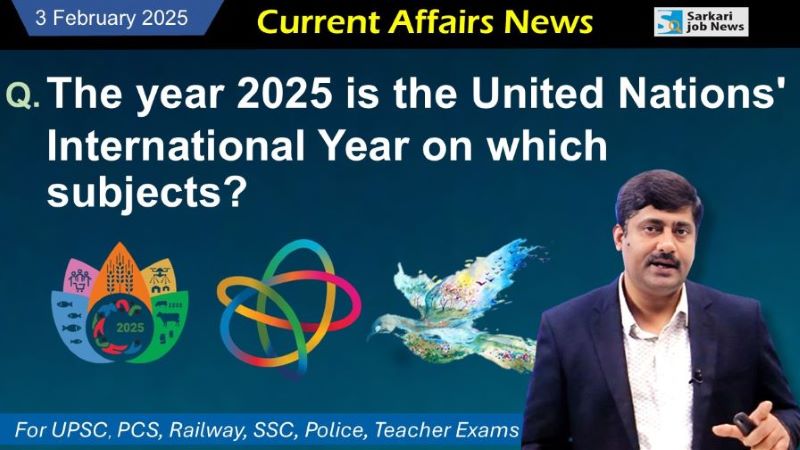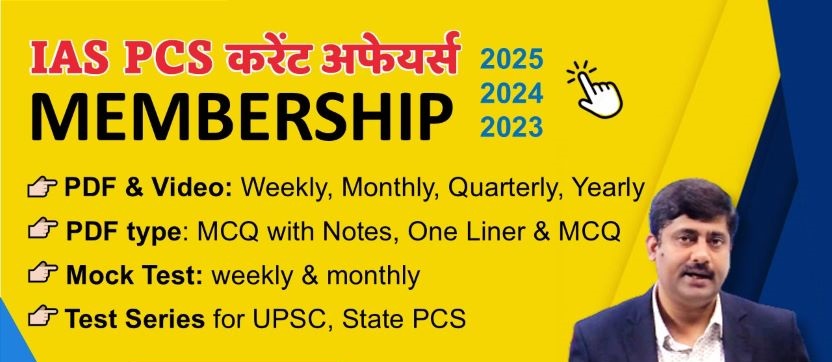This is the current affairs of 3 February 2025. Daily current affairs questions and answers are given here for better preparation of the competitive examination for government jobs.
PDF Download: Click here
1. Whose tableau in the Republic Day 2025 parade got the first prize by the judges in the ‘State or Union Territory Category’?
a. Uttar Pradesh
b. Jammu and Kashmir
c. New Delhi
d. Maharashtra
Answer: a. Uttar Pradesh
– Republic Day tableaux received two types of awards.
– One award was given by a panel of judges, and the other was given by citizens through voting on the MyGov portal.
Best Tableaux Declared by the Judges’ Panel (States and UTs):
– First Prize: Uttar Pradesh. The theme of this tableau was “Golden India: Heritage and Development.” It showcased the Mahakumbh-2025.
– Second Prize: Tripura’s tableau. The theme was “Eternal Faith: Worship of 14 Gods in Tripura – Kharshi Puja.”
– Third Prize: Andhra Pradesh’s tableau. The theme was “Atikoppaka Bommalu – Eco-Friendly Wooden Toys.”
Tableaux in the “Popular Choice Category” by Citizens on MyGov Portal:
– First: Gujarat (Golden India: Heritage and Development)
– Second: Uttar Pradesh (Mahakumbh 2025 – Golden India: Heritage and Development)
– Third: Uttarakhand (Uttarakhand: Cultural Heritage and Adventure Sports)
————-
2. Whose tableau in the Republic Day 2025 parade got the first prize in the category of ‘Central Ministries/Departments’?
a. Ministry of Home Affairs
b. Ministry of Tribal Affairs
c. Ministry of Defence
d. Ministry of External Affairs
Answer: b. Ministry of Tribal Affairs (with its inspirational and culturally rich tableau based on “Tribal Pride Year” to commemorate the 150th Birth Anniversary Year of Lord Birsa Munda)
Best Tableaux Declared by the Judges’ Panel (States and UTs):
– The Ministry of Tribal Affairs was awarded the best tableau by central ministries/departments at the 76th Republic Day Parade 2025 for its inspiring and culturally rich tableau based on “Tribal Pride Year” in celebration of the 150th birth anniversary of Bhagwan Birsa Munda.
– The tableau beautifully depicted tribal customs with a grand banyan tree, symbolizing strength, stability, and the deep connection between tribal communities and nature.
Tableaux in the “Popular Choice Category” by Citizens on MyGov Portal:
– Best Tableau among Central Ministries/Departments: Ministry of Women and Child Development (showcasing the multifaceted journey of women and children nurtured under the ministry’s broad schemes).
—-
Best Marching Contingents: A Display of Discipline and Excellence
Judges’ Choice:
– Best Marching Contingent in Services: Jammu and Kashmir Rifles Contingent
– Best Marching Contingent in CAPF/Other Auxiliary Forces: Delhi Police Marching Contingent
Popular Choice (MyGov Poll):
– Best Marching Contingent in Services: Signal Contingent
– Best Marching Contingent in CAPF/Other Auxiliary Forces: CRPF Marching Contingent
————-
3. Which year was declared by the United Nations (UN) as the International Year for the Conservation of Glaciers?
a. 2025
b. 2024
c. 2023
d. 2022
Answer: a. 2025
– UNESCO and the World Meteorological Organization jointly declared 2025 as the International Year for Glacier Conservation (IYGP) on January 21, 2025.
– To launch the International Year for Glacier Conservation 2025, a high-level launch event was held on January 21, 2025, in Geneva, Switzerland, and online.
– The event highlighted the growing global concern for the protection of glaciers, as they are a critical source of freshwater for more than 2 billion people.
– This international year focuses on garnering global cooperation, promoting research, and making cryosphere-related data more accessible to mitigate the impacts of rapidly melting glaciers.
Note: The United Nations (UN) weather experts (WMO) confirmed that 2024 was the hottest year on record, with temperatures 1.55°C higher than pre-industrial levels.
– Additionally, it was announced that from 2025 onwards, every March 21 will be observed as World Glacier Day.
Which country has lost all of its glaciers?
– Venezuela is the first country to lose all of its glaciers.
– In May 2024, scientists announced that Venezuela’s last remaining glacier, the Humboldt Glacier, is now gone.
– Scientists had expected the Humboldt Glacier to last for another decade. However, it melted at a faster rate than anticipated.
– Venezuela used to be home to six glaciers.
– By 2011, five of these glaciers had already disappeared.
Why did the glaciers disappear?
– The major reason for this is global warming.
– El Niño refers to the unusually warm surface waters in the equatorial Pacific Ocean, causing the ocean waters to heat up.
– Climate scientists and weather historians, such as Maximiliano Herrera, reported to The Guardian that in the Andean region of Venezuela, temperatures increased by +3°C/+4°C above the 1991-2020 average, which is unusual for such a tropical area.
– According to a 2023 study, glaciers around the world, like the Humboldt Glacier, are rapidly shrinking.
– Due to current climate change, it is estimated that two-thirds of glaciers could melt by 2100.
What are glaciers?
– Glaciers are large, thick masses of ice that form on land due to centuries of accumulated snow.
– They are typically found in areas where the average annual temperature is close to the freezing point.
– Due to their massive size and gravity, glaciers flow like slow-moving rivers.
Why are glaciers melting?
– Glaciers are melting due to global warming.
– Just like a piece of ice melts when it comes into contact with heat, glaciers are melting due to warmer temperatures. – These temperatures are caused by greenhouse gases (GHGs).
– Carbon dioxide and methane levels in the atmosphere have increased, leading to a rise in global temperatures.
– As a result, heatwaves, floods, droughts, rising sea levels, and the disappearance of glaciers have begun.
– A mountain range that passes through the Andes, Argentina, Bolivia, Chile, Colombia, Ecuador, Peru, and parts of Venezuela has experienced an increase in temperature at a rate of 0.10°C over the past seven decades.
– This is a major reason why Venezuela has lost all its glaciers.
What are the consequences of glaciers disappearing?
– Glaciers are a source of freshwater, especially during hot and dry weather.
– Their disappearance means people would have to rely entirely on rainfall for freshwater.
– The cold water flowing from glaciers helps maintain the temperature of water downstream.
– Many aquatic species require cold water temperatures to survive. The loss of glaciers directly impacts these species.
– Experts suggest that Venezuela’s Humboldt Glacier does not contain enough ice to contribute to sea level rise.
– However, if larger glaciers melt, it could lead to a rise in sea levels, threatening coastal cities.
Threat to glaciers in India
– According to a 2023 report, glaciers in the Hindu Kush Himalaya mountain range are melting. If emissions of gases are not reduced, the volume of these glaciers could decrease by up to 80% this century.
World Meteorological Organization (WMO)
– Headquarters: Geneva, Switzerland
– Parent Organization: United Nations (UN)
– Secretary-General: Professor Celeste Saulo
– Established: 1950
————-
4. Which year was declared by the United Nations (UN) as the International Year of Peace and Trust?
a. 2024
b. 2025
c. 2026
d. 2023
Answer: b. 2025
– The General Assembly passed a resolution on March 21, 2024, declaring 2025 as the International Year of Peace and Trust.
– The resolution calls on the international community to resolve conflicts through dialogue so that peace and trust can be strengthened between the member countries of the United Nations.
– In a separate resolution, the General Assembly declared November 15 as the International Day for the Prevention of all Forms of International Organized Crime and the Struggle Against it.
————-
5. Which year was declared by the United Nations (UN) as the International Year of ‘Quantum Science and Technology’?
a. 2026
b. 2027
c. 2025
d. 2024
Answer: c. 2025
Why was the International Year chosen?
– The year 2025 was chosen as the International Year because it marks the 100th anniversary of the early development of quantum mechanics.
– It has been a century since the publication of the paper by Werner Heisenberg, in which he laid the foundation for modern quantum mechanics.
What is Quantum?
– Quantum means “a small piece” or “the smallest unit.”
– The word comes from Latin, meaning “how much” or “an amount.”
Examples:
– Quantum of light: Photon
– Quantum of electricity: Electron
– Quantum science and quantum technology are fields based on quantum theory, using these principles to develop new technologies and tools.
When was the National Quantum Mission announced?
– The Government of India announced the ‘National Quantum Mission’ in April 2023, with a budget of ₹6,000 crore.
– It will be implemented by the Department of Science and Technology (DST) from 2023 to 2031.
– According to the senior advisor and head of the mission, there will be four verticals:
1. Quantum Computing
2. Quantum Communication
3. Quantum Sensing and Metrology
4. Quantum Materials and Devices
Founders of Quantum Theory
– Many scientists contributed to the development of quantum theory. Some key contributors include:
– Max Planck
– Albert Einstein
– Niels Bohr
– Werner Heisenberg
– Erwin Schrödinger
————-
6. Which year was declared by the United Nations (UN) as the International Year of Cooperatives?
a. 2025
b. 2026
c. 2027
d. 2028
Answer: a. 2025
– The purpose of this International Year is to highlight the important role of cooperatives in sustainable development.
The theme for the year 2025 is “Cooperation Builds a Better World.”
– Earlier, the year 2012 was declared as the United Nations International Year of Cooperatives.
International Cooperative Conference
– For the first time in India, the International Cooperative Conference was held on November 25, 2024, at the Bharat Mandapam in New Delhi.
– ICA full form – International Cooperative Alliance
– The conference was inaugurated by Prime Minister Narendra Modi.
International Years for 2025 on the following topics:
– International Year of Cooperation
– International Year of Quantum Science and Technology
– International Year of Peace and Trust
– International Year of Glacier Conservation
————-
7. The Union Cabinet approved the ‘National Critical Mineral Mission’ worth how many crore rupees in seven years?
a. Rs 20,200 crore
b. Rs 24,800 crore
c. Rs 34,300 crore
d. Rs 35,150 crore
Answer: c. Rs 34,300 crore
– The central government approved ₹16,300 crore for the National Critical Minerals Mission on January 29, 2025.
– A total of ₹34,300 crore will be spent on this mission over the next seven years.
– The goal of this mission is to make India self-reliant and promote the transition towards green energy.
– According to the Ministry of Mines, government companies will contribute ₹18,000 crore to this mission. The mission aims to boost the exploration of essential minerals both domestically and internationally.
Global Demand for Minerals
– Minerals like copper, lithium, nickel, cobalt, and rare earth elements are crucial because they are used in the development of clean energy technologies.
– These minerals are used in making wind turbines, power grids, electric vehicles, and batteries.
– Due to the global shift towards clean energy, the demand for these minerals is rapidly increasing.
Auction of 24 Mineral Blocks
– To promote the exploration and mining of essential minerals, the government amended the Mines and Minerals (Development and Regulation) Act of 1957 in 2023. After this, 24 mineral blocks were auctioned.
– Additionally, the Geological Survey of India (GSI) has initiated 368 exploration projects over the past three years. Currently, 195 projects are underway in 2024-25.
– In 2025-26, GSI will begin work on 227 new projects to further advance the exploration of essential minerals.
————-
8. Assam Chief Minister announced to develop which district as the second capital of the state?
a. Tezpur
b. Guwahati
c. डिDibrugarh
d. Silchar
Answer: c. Dibrugarh
– Chief Minister Himanta Biswa Sarma announced on January 26, 2025, that Dibrugarh will be developed as the second capital of Assam.
– He mentioned that Dibrugarh, the center of the British-era tea, oil, and coal trade, will become the second capital of Assam by 2027.
– The construction of a permanent assembly building in Dibrugarh will begin on January 25, 2026.
Other Decisions
– Additionally, he announced similar plans for Tezpur and Silchar.
– The Raj Bhavan (Governor’s Residence) will be established in Tezpur, which will emerge as the cultural capital of the state.
– In Silchar, a mini secretariat and Chief Secretary’s office will be set up.
About Dibrugarh
– Dibrugarh is an industrial city in Upper Assam, known for its vast tea plantations. It is also a center for tea, oil, and coal trade.
– It is located 435 kilometers east of the state capital, Dispur. – Dibrugarh is the district headquarters of Dibrugarh district in Assam.
– Dibrugarh district, with only one subdivision, is situated in the eastern part of Assam.
– The district covers an area of 3,381 square kilometers.
– The Brahmaputra River flows along the northwestern border of the district.
About Assam
– Assam is located in the northeastern part of India.
– Borders: Bhutan, Bangladesh, and the Indian states of Arunachal Pradesh, Nagaland, Manipur, Meghalaya, Tripura, Mizoram, and West Bengal.
– Capital: Dispur
– Governor: Laxman Prasad Acharya
– Chief Minister: Himanta Biswa Sarma
————-
9. Latika Katt died on 25 January 2025, which of the following was she?
a. Sculptor
b. Lyricist
c. Poetess
d. Actress
Answer: a. Sculptor
– 76-year-old Latika Katt was renowned for decorating large sculptures of public figures using materials such as terracotta, paper-mâché, stone, and bronze.
– Her work wasn’t limited to human figures; she also enjoyed studying the organic forms of nature and translating them into sculptures.
– She studied at Banaras Hindu University (BHU).
– Before sculpting, she would study the locations, map the direction of the wind, and plan the perspectives.
– Her bronze sculpture “Makar Sankranti Nahan” won the Beijing Art Biennale Award in 2010.
Notable Works
– Some of her most acclaimed works include sculptures of prominent figures such as Ramkinkar Baij, the father of modern Indian sculpture, Somnath Hore, Mulk Raj Anand, Mahatma Gandhi, and Jawaharlal Nehru.
————-
10. In which state was the International Saraswati Mahotsav organized in January, February 2025?
a. Bihar
b. Himachal Pradesh
c. Punjab
d. Haryana
Answer: d. Haryana
– The International Saraswati Mahotsav was launched on 29 January 2025 in Kurukshetra, Haryana, which will run till 4 February.
– It will showcase the rich cultural heritage, traditions and arts of Haryana.




